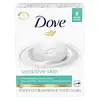What's inside
What's inside
 Key Ingredients
Key Ingredients

 Benefits
Benefits

 Concerns
Concerns

 Ingredients Side-by-side
Ingredients Side-by-side

Aloe Barbadensis Leaf Juice
Skin ConditioningCamellia Sinensis Leaf Extract
AntimicrobialSodium Coco-Sulfate
CleansingDecyl Glucoside
CleansingSodium Chloride
MaskingCoco-Glucoside
CleansingGlycerin
HumectantPanthenol
Skin ConditioningSimmondsia Chinensis Seed Oil
EmollientSymphytum Officinale Leaf Extract
Skin ConditioningUrtica Dioica Leaf Extract
Skin ConditioningMacrocystis Pyrifera Extract
Skin ConditioningLepidium Meyenii Root Extract
Skin ConditioningYucca Brevifolia Root Extract
Skin ConditioningSalix Alba Bark Extract
AstringentBenzyl Alcohol
PerfumingCitric Acid
BufferingDehydroacetic Acid
PreservativePotassium Sorbate
PreservativeAloe Barbadensis Leaf Juice, Camellia Sinensis Leaf Extract, Sodium Coco-Sulfate, Decyl Glucoside, Sodium Chloride, Coco-Glucoside, Glycerin, Panthenol, Simmondsia Chinensis Seed Oil, Symphytum Officinale Leaf Extract, Urtica Dioica Leaf Extract, Macrocystis Pyrifera Extract, Lepidium Meyenii Root Extract, Yucca Brevifolia Root Extract, Salix Alba Bark Extract, Benzyl Alcohol, Citric Acid, Dehydroacetic Acid, Potassium Sorbate
 Reviews
Reviews

Ingredients Explained
These ingredients are found in both products.
Ingredients higher up in an ingredient list are typically present in a larger amount.
Glycerin is already naturally found in your skin. It helps moisturize and protect your skin.
A study from 2016 found glycerin to be more effective as a humectant than AHAs and hyaluronic acid.
As a humectant, it helps the skin stay hydrated by pulling moisture to your skin. The low molecular weight of glycerin allows it to pull moisture into the deeper layers of your skin.
Hydrated skin improves your skin barrier; Your skin barrier helps protect against irritants and bacteria.
Glycerin has also been found to have antimicrobial and antiviral properties. Due to these properties, glycerin is often used in wound and burn treatments.
In cosmetics, glycerin is usually derived from plants such as soybean or palm. However, it can also be sourced from animals, such as tallow or animal fat.
This ingredient is organic, colorless, odorless, and non-toxic.
Glycerin is the name for this ingredient in American English. British English uses Glycerol/Glycerine.
Learn more about GlycerinChances are, you eat sodium chloride every day. Sodium Chloride is also known as table salt.
This ingredient has many purposes in skincare: thickener, emulsifier, and exfoliator.
You'll most likely find this ingredient in cleansers where it is used to create a gel-like texture. As an emulsifier, it also prevents ingredients from separating.
There is much debate on whether this ingredient is comedogenic. The short answer - comedogenic ratings don't tell the whole story. Learn more about comegodenic ratings here.
The concensus about this ingredient causing acne seems to be divided. Research is needed to understand if this ingredient does cause acne.
Scrubs may use salt as the primary exfoliating ingredient.
Learn more about Sodium Chloride